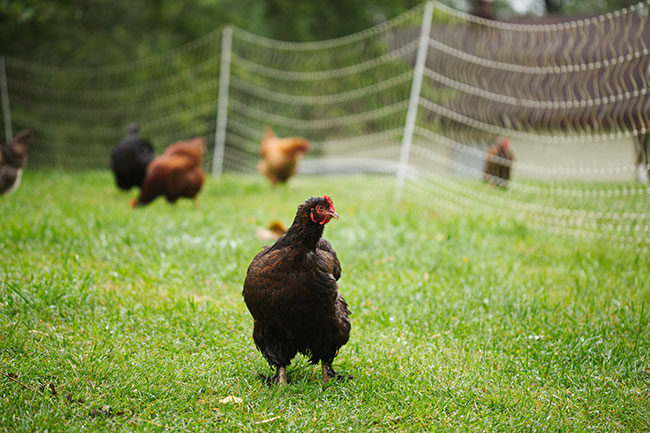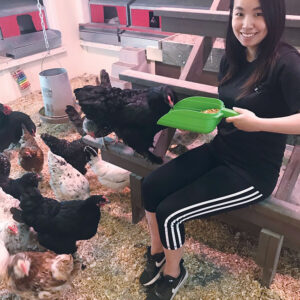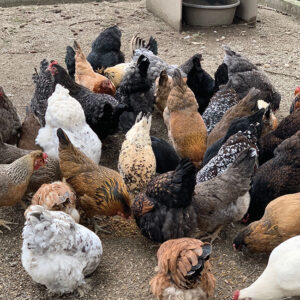
Avian Influenza: Small flocks, big risks
By Treena Hein
Features Disease watch Migration MattersSmall flock owners in Canada have access to only a limited number of bird health and biosecurity resources. However, with ongoing HPAI challenges, a handful of experts are working to change that.
 As the number H5N1 outbreaks grew across the country, governments and organizations prioritized educating small flock owners about biosecurity protocols.
PHOTO CREDIT: © Erika Norris / Adobe Stock
As the number H5N1 outbreaks grew across the country, governments and organizations prioritized educating small flock owners about biosecurity protocols.
PHOTO CREDIT: © Erika Norris / Adobe Stock As everyone in the poultry industry well recalls, it was January 2022 when Canada’s first two outbreaks of the current highly pathogenic avian influenza (HPAI) strain were confirmed. Both sites were small flock operations in Newfoundland.
No one was particularly surprised. Wild birds are known to carry HPAI and it’s common for small flock operations to have small bodies of water where their poultry can mingle with wild birds. This was the case with these infected sites, both located on the Avon Peninsula.
At one site, 350 birds of various heritage breeds died of infection and another 60 (including geese, peacocks and an emu) were euthanized. At the other site, it was about 15 chickens and ducks.
Of course, as the number of outbreaks grew across the country, biosecurity became a strong industry focus, and the education of small flock owners was stepped up.
Well before the 2022 HPAI outbreaks, in 2018, Dr. Leonardo Susta at University of Guelph found that backyard flock owners in Ontario were not following basic biosecurity protocols that prevent disease.
In Susta’s survey, fewer than 50 per cent of small flock owners reported having dedicated shoes or clothing for entering their coops. Less than five per cent of respondents reported using a foot bath to wash footwear, and more than 60 per cent reported allowing visitors into the coop or barn.
Many experts would say the same was occurring, and still occurs, in all parts of the world – on both sites with small flocks and also commercial barns. And while Susta stated at the time of his study release, “We wouldn’t expect backyard chicken owners to apply the same biosecurity practices used with commercial flocks, but there are certainly steps that flock owners should be taking.”
However, small flock owners in Canada can only access a limited number of bird health and biosecurity resources, explains Dr. Gigi Lin, a veterinarian at Canadian Poultry Consultants in Abbotsford, B.C., who works very closely with small flock owners in her province (and beyond, digitally). She adds that, “In addition to limited resources, small flock owners experience an overall lack of veterinary support as well.”
That’s why Lin started Small Flock Veterinary Care (within Canadian Poultry Consultants) in 2018, which not only offers vet services but also education for non-poultry veterinarians so that they are better prepared to for poultry cases. Through the Canadian Animal Health Surveillance System program, for example, Lin will be launching an online course for non-poultry veterinarians in April, in collaboration with Dr. Victoria Bowes, an avian pathologist with the B.C. government.
And in mid-2022, through a funding program offered to small flock owners by the Yukon government (in which registered flock owners receive $1000 per year for vet services), Lin presented to these owners on biosecurity practices and HPAI.
These are only two of the expanded education efforts to help small flock owners in Canada prevent, recognize and deal with disease and the threat of further HPAI outbreaks. And while education of small flock owners is primarily the responsibility of the provincial/territorial governments and related industry associations, the Canadian Food Inspection Agency (CFIA) also plays a role.
The CFIA website offers a range of biosecurity and AI prevention resources on its website for small flock owners, and also runs spring and fall awareness campaigns every year to encourage them to enhance their biosecurity practices in order to protect their birds. The CFIA is also working with industry, veterinary and government partners with outreach activities.
This includes meetings, information sessions and webinars across the country, such as a small flock HPAI webinar hosted by the Poultry Industry Council (PIC) in 2022.
Before and after
Prior to the first confirmed case of the current HPAI, staff at the Ontario Ministry of Agriculture, Food and Rural Affairs had provided backyard poultry owners with biosecurity, flock health and emergency management information. After the first declared case in Ontario, staff held weekly evening webinars in partnership with PIC for small flock owners and others, 26 webinars in all.
Speakers from a variety of organizations provided expert input, including the Canadian Wildlife Health Cooperative, the Canadian Wildlife Service, but also the Canadian Mental Health Association, to help those with poultry address the stressful situation. The ministry reports that others carried out further education and outreach to small flock owners, including feed industry representatives, the organic industry and Ontario’s Mennonite community.
In B.C., for years the Ministry of Agriculture and Food has provided resources online and at different events for small flock owners. Ministry veterinarians also conducted general small flock workshops in different communities around the province that focussed on bird health, food safety, animal care and management, says a spokesperson.
After the outbreaks started, “B.C. government veterinary specialists offered in-person HPAI-specific information sessions in five regions throughout the province for small flock poultry owners to help them protect their birds and let them know how to prevent, recognize and report the virus, as well as two virtual sessions open to anyone in the province.” The ministry also created a range of resources in response to the HPAI outbreak for backyard and commercial operators.
Specifically for small flock owners, the ministry also set up a help line for producers to ask questions about bird health and to access diagnostic testing services through its Animal Health Centre.
However, despite all this, the ministry notes that reaching small flock owners can be difficult, as most operate independently and are not represented by a provincial or regional association.
This can present challenges in keeping people up-to-date with information.
Indeed, some of the in-person workshops it offered were cancelled due to low registration, but the spokesperson says, “The ministry will continue its education efforts through our web resources, regional agrologists, farming networks and contacts.”
For her part, Lin is very pleased to see the increased number of biosecurity and health resources for small flock owners, especially compared to about five years ago. “It’s very positive,” she says, “and hopefully even more resources will be added.”
She adds, “I think it would also be beneficial to both small flock owners and commercial operators in the future, if we had a more advanced reporting system for diseases observed in small flocks.
“Because small flocks are usually kept outdoors for at least part of the year, they are a sentinel for infectious diseases that also affect commercial operations, a sort of canary in the coalmine.
“I believe more surveillance and reporting of small flock disease issues would be helpful to everyone who farms poultry across Canada, large and small.”
The spokesperson adds, “The ministry will continue its education efforts through our web resources, regional agrologists, farming networks and contacts.”
Factors affecting whether a small flock will experience HPAI
A CFIA presentation to small flock owners in March 2022 noted that their risk of HPAI infection is higher depending on the answers to a range of questions, including:
- Are migratory waterfowl present in the area?
- Is there a flock confirmed with AI near by?
- How close is the nearest poultry farm?
- How close is this flock to a domestic waterfowl flock?
- Are waterfowl present on this farm?
- Do birds from this flock have access to outdoors?
- How close is the nearest surface water (pond, slough) to the barn?
- Do family members or employees have contact with wild waterfowl (e.g. hunting) on or near the premises?
- Are wild birds such as starlings able to enter the barn and eat from the feeders?
Print this page

